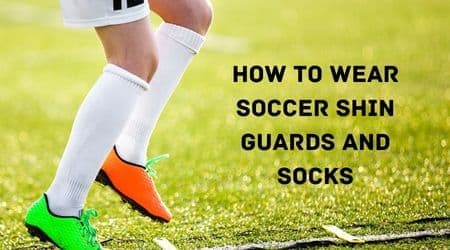To wear soccer shin guards, first position them over your shins and secure them with straps or sleeves. Then, pull your socks up over the guards to ensure full coverage and a snug fit.
Entering the field with the right gear is essential for soccer players of all levels. Shin guards, a key piece of protective equipment, offer defense against potential injuries during the game's inevitable contact. Wearing them correctly maximizes their effectiveness and keeps the player focused on the game rather than adjusting their equipment.
Properly fitted shin guards should be lightweight, strong, and comfortable, providing a shield without impairing mobility. Combining them with the correct socks not only secures them into place but also contributes to a player's uniformity and adherence to team regulations. It’s critical to appreciate the balance between protection and comfort when gearing up, ensuring that the basics don't distract from performance on the pitch.
Importance Of Wearing Shin Guards And Socks
Importance of wearing shin guards and socks in soccer cannot be overstated. These pieces of gear are fundamental to a player's safety and adherence to the sport's regulations. Let's explore their critical roles on the field.
Protection For Shin And Ankle
Shin guards and socks work together to shield a player's legs. Players face hard kicks and aggressive slides frequently. Without proper guards, these impacts could lead to bruising, fractures, or worse. Here's how they protect:
- Cover vulnerable areas: The shin and ankle are prone to injury.
- Soft padding: Shin guards have padding that absorbs shocks.
- Prevent cuts: Socks keep guards in place and skin safe from abrasions.
Compliance With Rules
According to soccer rules, players must wear shin guards. Compliance ensures fair play and reduces injury risks. Here's why it's a rule:
| Reason | Explanation |
|---|---|
| Safety standards | Guards are required to meet certain safety criteria. |
| Level playing field | All players must have the same protective gear. |
Not wearing shin guards and socks impacts a player's ability to perform. It also goes against team regulations. Each player must have them for matches.
Choosing The Right Shin Guards
Protecting your shins is critical in soccer. Right shin guards can mean the difference between a great play and an injury. Let's dive into how to select the best shin guards for your game.
Types Of Shin Guards
Soccer players can choose from different types of shin guards based on their needs:
- Slip-In: Lightweight and used by experienced players.
- Ankle Guards: Offer extra ankle protection for beginners.
- Shin Socks: Combine shin protection and socks in one.
Factors To Consider
Several factors are essential when selecting shin guards:
- Size: Shin guards should cover from your ankle to below your knee.
- Fit: They must fit snugly against your shin without slipping.
- Level of Play: Higher level players may need lighter guards.
- Material: Look for durable materials that offer good protection.
| Material | Weight | Protection Level |
|---|---|---|
| Foam Rubber | Light | Moderate |
| Polyurethane | Heavier | High |
| Plastic | Varies | Good |
Remember to check the shin guard's NOCSEA seal to ensure they meet safety standards. Also, consider comfort and season playing conditions before making your choice. With the correct pair, you’ll play with confidence and stay safe on the field.
Selecting The Right Socks
Selecting the Right Socks is as crucial as choosing the best shin guards for your soccer game. Your socks will support and protect your legs during play. They need to be comfortable, durable, and suitable for your specific needs. Let's explore what makes the ideal soccer sock.
Material
Fabric of your soccer socks is important. It can affect comfort, durability, and even performance. Socks made from synthetic fibers, like polyester or nylon, wick away sweat. This keeps your feet dry. Other materials like cotton, can retain moisture. Choose breathable and quick-drying material for the best experience on the pitch.
- Polyester: Lightweight and moisture-resistant.
- Nylon: Strong and maintains its shape.
- Spandex: Adds stretch and ensures the sock stays up.
- Cotton: Comfortable but less desirable for moisture management.
Length
Soccer socks must be long enough to cover your shin guards completely. This ensures protection and keeps the guards in place. Socks should stretch above the calf and stay snug. Length also plays a role in comfort and can prevent the sock from sliding down. Most soccer socks are knee-high to meet these needs.
| Size | Length (Approx.) | Age Group |
|---|---|---|
| Small | 12″-16″ | Children |
| Medium | 16″-20″ | Teens |
| Large | 20″-24″ | Adults |
Remember, proper fit ensures comfort and better gameplay. Get the right size to match your shin guard and calf length.
Check this : 10 Best Long Football Socks
Preparing For Shin Guard And Sock Application
Before playing soccer, wearing shin guards and socks correctly is essential. This ensures protection and comfort on the field. Follow these steps to prepare your gear properly.
Washing And Drying
Keeping your shin guards clean is a must. Dirty gear can cause skin irritation and unpleasant odors. Here's how to maintain them:
- Read the manufacturer's instructions to understand the suitable cleaning method for your shin guards.
- Use mild soap and water to wash them after each game or practice.
- Air dry your shin guards completely before wearing them again. Avoid using heat, as it can damage the material.
For socks, follow similar steps:
- Turn them inside out to remove any dirt.
- Machine wash with cool water and mild detergent.
- Air drying is best to preserve elasticity, but tumble dry on low if necessary.
Having Proper Equipment
Correct equipment ensures your safety and enhances your gameplay. Remember these tips:
- Choose shin guards that fit snugly around your shins without restricting movement.
- Shin guards should cover from just below the knee to above the ankle.
- Your socks must be long enough to cover the shin guards entirely.
Sizing is crucial. Get professionally sized if you're unsure. This avoids discomfort and potential injury.
How To Wear Shin Guards And Socks
Stepping onto the soccer field requires not just skill but also proper protection. One essential piece of equipment is the shin guard, coupled with the correct pair of socks. This guide will ensure you suit up correctly and comfortably before the whistle blows.
Fitting The Shin Guards
Choosing the right shin guards is crucial for both safety and comfort. To fit the shin guards:
- Measure your leg from the knee to the base of your ankle. This length helps you find the correct size.
- Try the shin guards on with your soccer socks to ensure a snug, not tight, fit.
- Straps or sleeves should not dig into your skin or restrict movement.
- Ensure they are lightweight and durable for maximum comfort and protection.
The shin guard should cover most of the shin, with a couple of inches below the knee and above the ankle for the best fit.
Proper Positioning Of Socks
Once your shin guards are in place, positioning your socks correctly will keep everything secure. Here’s how:
- Pull your socks over the shin guards. They should be tight enough to hold the guards in place without restricting blood flow.
- Check alignment to ensure nothing shifts. The front of the shin guard should face forward, not tilt to the sides.
- If your socks have a designated heel area, align this with your heel before pulling them up.
Remember, socks must cover the entire shin guard during official matches. Choose socks that complement your uniform for a professional look.
Caring For Your Shin Guards And Socks
Shin guards and socks are vital in soccer, protecting players during the game. Proper care extends their life and ensures comfort and safety on the pitch. In this part of the blog, learn how to keep your soccer gear in top condition.
Cleaning And Maintaining
Keeping shin guards and socks clean is essential. Follow these simple steps:
- After every game, remove shin guards from socks.
- Air out shin guards to prevent odor and bacteria.
- Wash socks in cold water using a gentle cycle.
- Use mild soap to clean shin guards by hand.
- Rinse thoroughly and air dry both guards and socks.
Replacing When Necessary
Over time, your shin guards and socks will wear down. Recognize the signs:
| Shin Guards | Socks |
|---|---|
| Cracks or severe scratches | Holes or thinning fabric |
| Loose straps or padding | Loss of elasticity |
| Persistent odor after cleaning | Faded color or hard stains |
Replace old or damaged gear to stay safe and perform your best.
Troubleshooting Common Issues
Troubleshooting Common Issues with Soccer Shin Guards and Socks ensures comfort and safety. Occasional problems can arise, such as shin guards slipping or socks bunching. This guide addresses solutions to these frustrations.
Slipping Shin Guards
Shin guards should stay in place for optimal protection. A guard that slips can expose the shin to injury. Consider the following steps:
- Check for proper fit. Shin guards must match the player's size.
- Use shin guard sleeves. These can sustain the guard's position.
- Tighten straps. If your shin guards have straps, secure them snugly.
- Apply sports tape. Tape can anchor shin guards to the legs.
Bunching Of Socks
Socks should sit smoothly over shin guards. Bunching can lead to discomfort and distraction.
- Choose the right size. Ill-fitted socks often bunch.
- Layer correctly. First, pull on the shin guards, then the socks.
- Pull tight from the toes. This smooths out any wrinkles up the leg.
- Adjust as you play. If bunching occurs, smooth out the material.
Final Thoughts
As we wrap up our guide on wearing soccer shin guards and socks, let's solidify our learning. Remember, mastering the right way to wear them can enhance both safety and comfort on the pitch.
Practice Makes Perfect
Getting the hang of fitting your shin guards and socks just right might take a few tries. Stick with these tips for a snug, secure feel:
- Try on different sizes to find the best fit for your legs.
- Adjust the straps or sleeves for a firm hold without cutting off circulation.
- Pull your socks up over the shin guards to ensure full coverage.
- Engage in pre-game practices wearing your gear to get used to the feel.
Make Safety A Priority
Your shin guards serve as essential armor against injuries. Remember these points to keep safety in check:
- Choose shin guards that meet safety standards for maximum protection.
- Ensure they cover from the ankle to below the knee.
- Inspect for damage before and after games to catch any wear and tear.
- Never play without your shin guards—prevent risks wherever possible.
Frequently Asked Questions For How To Wear Soccer Shin Guards And Socks
Do You Put Socks Over Or Under Shin Guards?
Socks typically go over shin guards to secure them in place during play. This method keeps the guards from shifting and provides a seamless look on the soccer field.
How Do You Put On Soccer Socks With Shin Guards?
Start by pulling the soccer socks up to just below your knees. Slide shin guards into place, ensuring they cover your shins correctly. Pull the top part of your socks over the shin guards to secure them. Adjust for comfort and ensure full coverage of the shin guards.
Do Soccer Socks Go Over Regular Socks?
Yes, soccer players often wear soccer socks over thin regular socks to ensure comfort and proper fit of their soccer cleats.
Do Soccer Shin Guards Go Over Pants?
Soccer shin guards typically slide underneath soccer socks, not over pants. Ensure socks cover the guards entirely for proper protection during play.
Conclusion
Wrapping up, nailing the perfect fit for soccer shin guards and socks is crucial. From protecting your shins to ensuring comfort, your choice matters. Remember, equip yourself right to enjoy the game safely. Keep these tips in hand for confidence on the field.






